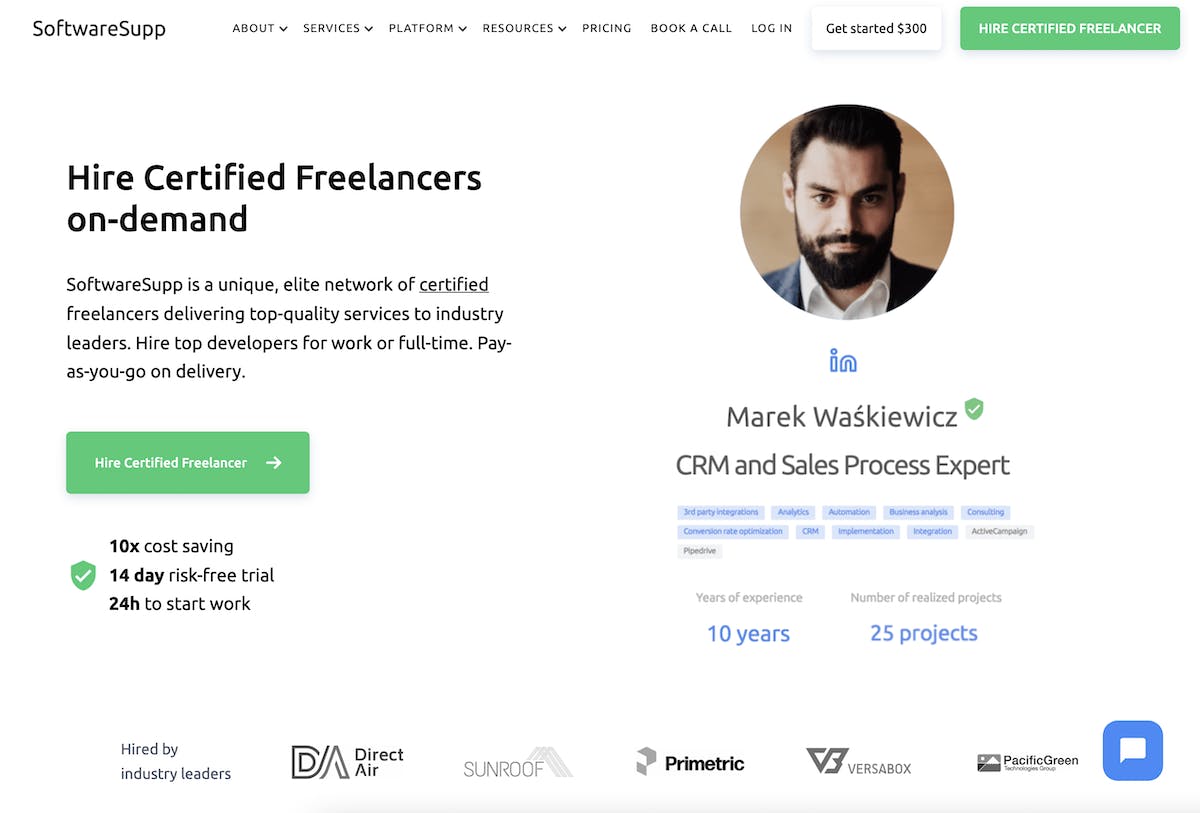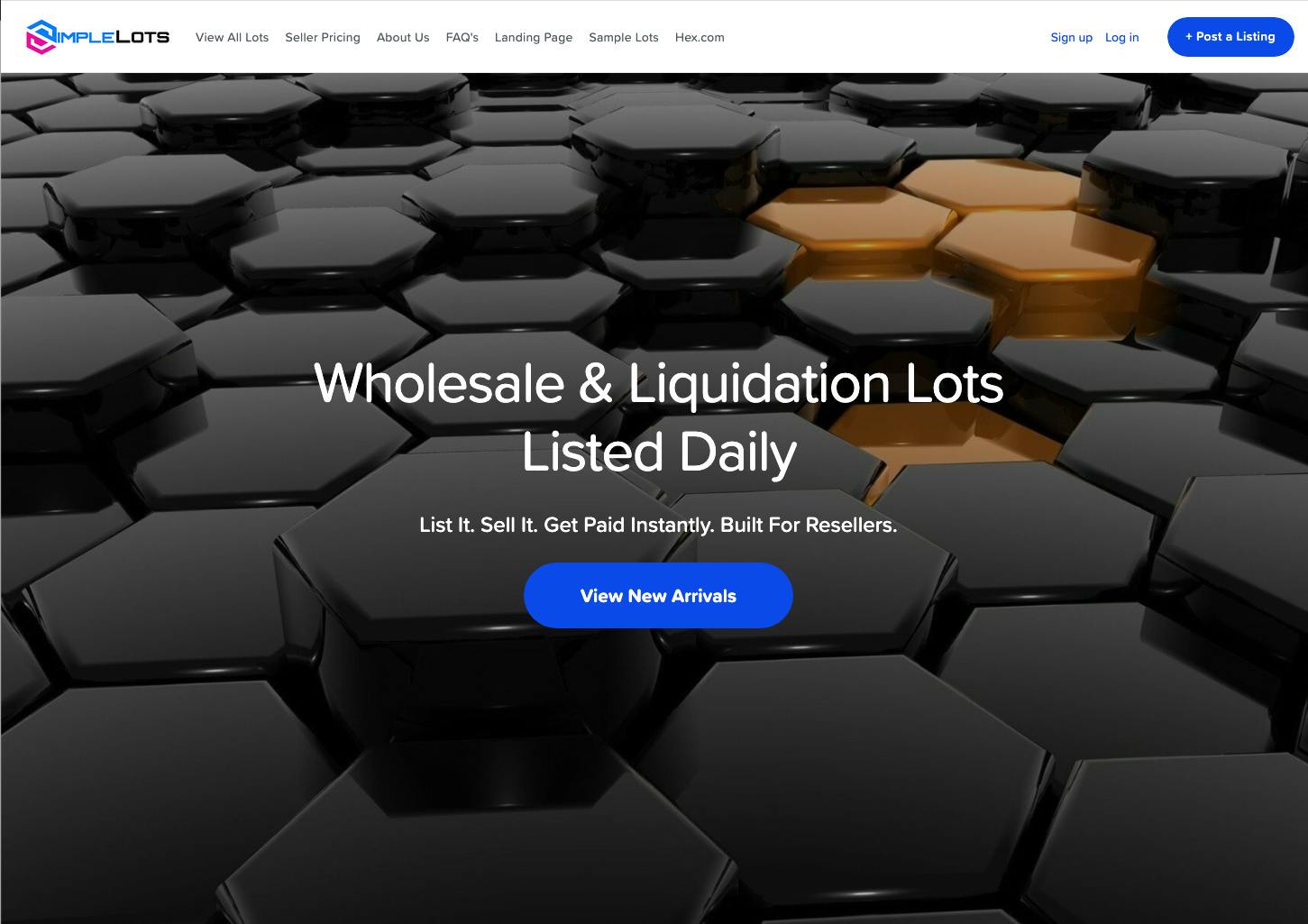The B2B marketplace opportunities
The B2B eCommerce market is massive. But unlike in B2C, where the marketplace model has spread across fields and industries, B2B is still largely blue ocean for marketplaces. Marketplaces entering the B2B sphere face challenges but also phenomenal growth opportunities.

Table of Contents
Chapter 1
B2B is an untapped marketplace opportunity
There's plenty of blue ocean left for the aspiring B2B marketplace entrepreneur.
The success of unicorns like Airbnb, Etsy, and Thumbtack has led to the adoption of the P2P/B2C marketplace model across fields and industries. B2B, however, has so far largely avoided the marketplace revolution.
This is despite the fact that B2B markets are massive. In 2019, the size of the global B2B eCommerce market was valued at $12.2 trillion. That is over six times the size of the B2C eCommerce market.
One possible explanation for the disparity is that compared to B2C, marketplaces entering B2B face a number of industry-specific challenges and platform requirements. Especially the B2B transaction and order flows (which I’ll get into later in this post) tend to be decidedly more complex than what’s required on a B2C or a P2P marketplace.
Despite the challenges, many investors have brought up B2B as the biggest untapped opportunity for marketplaces (check out our interviews with Josh Breinlinger, Fabrice Grinda, Ben Narasin, James Currier, and Mathias Ockenfels for thought-provoking analyses).
In the following article, I’ll analyze the opportunities and challenges of B2B marketplaces and unpack the core requirements for building a successful B2B platform.
Chapter 2
The marketplace opportunities in B2B
Several factors contribute to the potential business-to-business markets have for marketplaces.
The size of the B2B eCommerce market alone makes it an interesting opportunity. But there are several more factors that contribute to its potential, specifically from the viewpoint of a marketplace entrepreneur or a business looking to enrich its offerings with a platform approach.

"Holy Grail" transactions
It's generally thought that the best opportunities for marketplaces are markets that have either high transaction values or high transaction frequencies. This has been the case for some B2C and C2C unicorns like Airbnb (high value) and Uber (high frequency).
Somewhat contrary to this belief, the a16z Marketplace 100 study by the VC firm Andreessen Horowitz found that successful marketplaces can operate with all kinds of combinations. Even in the inauspicious low-value, low-frequency space, many B2C marketplaces have survived and thrived.
B2B marketplace can fall into the "Holy Grail" category where transactions are both high-value and high-frequency.
There is one category, however, the authors of the study label “The Holy Grail”: the space with both high purchase frequency and high average order value.
As the naming of the category suggests, this combination is difficult to find. Yet B2B marketplaces have tremendous potential to fall into the “Holy Grail” category. This is true for all B2B marketplace types: services such as freight, equipment or machinery rentals, or buying producer goods are often high-value transactions that happen on a recurring basis.
Inefficient processes
Virtually any demand a private customer has can nowadays be solved at the click of a button. In B2B, much of the high-value, high-frequency transactions still happen through surprisingly antiquated technologies. Pen-and-paper, phone, fax, and Rolodex aren’t things of the past when large corporations transact.
There are good reasons why B2B operations happen the way they do. Stakes are high in valuable transactions, so trust between parties is critical. Prices need to be negotiated, certifications and NDAs to be exchanged. Stages in the value chain may spread across multiple actors and geographic locations.
These complicated processes can produce significant inefficiencies – inefficiencies that a marketplace model could help overcome.
If a marketplace is able to solve the underlying requirements – trust, oversight, administrative requirements – while streamlining the steps, it can improve productivity in each step of the process. The possibility to offer efficiency – and convenience to the individuals responsible for these transactions – can make B2B marketplaces remarkably sticky and resistant to disintermediation.
Fragmented markets
Marketplaces are great at aggregating products or services and making them easily accessible. Marketplaces thrive in markets inhabited by lots of small players instead of big, centralized actors. This is very often the case in B2B.
In B2B, it’s not uncommon that a market consists entirely of a considerable number of small suppliers who operate their business with pen and paper without a proper online presence. Business is done through individual contacts or with the help of intermediaries such as brokers, traders, or agencies.
Building a marketplace to a market with high fragmentation could make finding a B2B provider infinitely easier and bring transparency and efficiency to the transactions. A marketplace can offer a streamlined alternative to the middlemen or work with them to increase efficiency in all three sides of the market.
Change of habits
The result of the B2C marketplace revolution is that as private consumers, we’re getting very accustomed to solving all kinds of problems through eCommerce and platforms. We’re familiar with the typical marketplace UX, we’re used to online payments, we’re confident with common trust-building mechanisms like reviews and identity verification.
The change of habits in B2C spills over to B2B, making it easier for individuals to turn to powerful procurement platforms also when they’re making purchases as representatives of a business. The barrier to adopting new technologies is significantly lower today than it was at the early stages of the marketplace wave.
B2B still has categories where no dominant marketplace solutions exist.
Blue ocean
Yet another clear difference between B2C and B2B is that new customer-facing marketplaces tend to need to take on existing competitors and innovate on products to compete. B2B still has categories where no dominant marketplace solutions exist.
Finding a blue ocean gives the founding team a chance to focus on solving the chicken-and-egg problem and achieving liquidity without battling an incumbent. As a result, the first mover gains the upper hand in building network effects and defensibility over time.
New ways to engage
For existing companies, a move into marketplaces can present an efficient way to add to their core offering. A multi-sided marketplace platform mitigates many of the risks of traditional business expansion, as third-party suppliers add their own manufacturing or service capability, marketing, and customer acquisition networks to the mix.
A marketplace may also offer businesses a new way of building relationships with their customers and increasing loyalty. An ecosystem of third-party suppliers can serve versatile customer needs in different stages of their journey and quickly adapt to new developments in the market.
In addition to these benefits, there are several reasons why the 2020s are a great time to build a B2B marketplace. I highly recommend this talk by James Currier at the latest Marketplace Conference, where he discusses these factors and gives away 24 tactics to make B2B marketplaces work.
Chapter 3
B2B marketplace challenges
The two core challenges for marketplaces entering a B2B market are mastering complex transactions and building trust.
Marketplaces – whether B2B, B2C, or P2P – are challenging businesses to build.
For one, marketplaces are more trust-sensitive than traditional eCommerce. Transaction flows and payment processing on marketplaces are intrinsically more complex. User acquisition, user retention, and liquidity-building strategies are complicated by the fact that, more often than not, marketplace customers and suppliers are two distinct user groups with different needs.
In B2B, many of these challenges are amplified. Let’s look at two core challenges: transactions and trust.
Complex transactions
In the world of B2B, the process of placing an order is typically a lot more complex than in B2C and C2C.
Sales cycles may be longer and involve a lengthy process from an RFP to negotiation, proposal, and contract. Several types of certifications, verifications, and NDA agreements may be needed. Suppliers may be used to working with cost estimates rather than exact quotes, so the customer side may want actual costs to be tracked, reported, and billed according to a Purchase Order. Organizations may also have specific requirements regarding payment types, billing, and credit terms.
The complexity of B2B transactions creates a two-fold challenge for an early-stage marketplace entrepreneur. First, understanding all the stages in the transaction flow and the reasoning behind them takes empathy and domain expertise. Second, bringing a complex transaction process to a platform and perfecting the UX demands sophisticated technology and exceptional product management.
At Sharetribe, we aim to help founders solve this challenge. Our API-based marketplace solution offers a powerful, fully customizable transaction engine that lets developers easily build and modify complex transaction flows. Read more about Sharetribe Flex.
Perfecting a complex B2B transaction process on a marketplace isn't easy.
High-trust markets
B2B transactions can include relatively high risks for the responsible individual and the organization. While the large transaction value is a tremendous opportunity for a marketplace, the high average order value also creates a higher need to trust the supplier and the platform. A failure to successfully purchase a critical service or item may delay entire projects, jeopardize stakeholder relationships, and put entire teams into difficult positions.
In B2B, trust between supply partners may have been built over several years, and deals often take place through deep-rooted relationships and invisible networks. To successfully move these relationships to the platform, a marketplace entrepreneur must invest in long-term trust-building strategies.
Chapter 4
B2B marketplace requirements
How to negotiate the challenges and leverage the potential of B2B with marketplace tech and tactics.
After looking at both the opportunities and challenges, let’s dive into what it takes from a marketplace to mitigate the risks and leverage the potential in B2B.
Supporting the transaction through each step
Facilitating payments is a core value proposition for a marketplace. Especially so in B2B, where a marketplace can offer a smooth, convenient process to replace countless steps of back-and-forth. Done right, seamless payment processing alone can significantly increase the stickiness of a B2B marketplace.
Owing the transaction is also a common strategy for a marketplace to monetize. Whenever a payment takes place, a marketplace charges a commission from the customers, the providers, or both. The benefit of the commission-based business model is that it creates no additional costs to either party before they’ve struck a deal, decreasing the barrier of entry. For B2B businesses, in particular, subscription-based revenue models are also relatively common, mainly if their offering includes powerful SaaS tools for one side of the marketplace (more on that later).
The transaction process of a marketplace defines all the possible interactions between a customer and a provider. Do customers search for suppliers, or do providers reach out to the customers? Does a pre-booking take place, or do the parties begin with an RFP and a negotiation? Do verifications occur, are certifications exchanged, are contracts or NDAs signed? How and when does payment happen?
A customizable transaction engine helps you unlock the biggest B2B marketplace opportunities.
Technically, mastering these steps requires seamless interaction between a powerful back-end transaction engine and an intuitive UX (and possibly a payment service provider). Compliance with regulatory guidelines regarding online payments and data protection need accounted for as well.
The transaction process has the potential to unlock the most significant opportunities of the marketplace model. At the same time, it represents a marketplace’s biggest technical challenge. That’s why building a flexible, easily customizable transaction engine has been at the core of developing Sharetribe Flex to be the most advanced marketplace software solution on the market. Read more about Sharetribe Flex features.
Curating the supply & matching it with the demand
High-quality supply is of the essence in any marketplace. Freightos CEO Ruthie Amau talks about this point at length in a recent Two-sided podcast episode, as does Kevin Lustig, founder of Scientist.org.
Typically, ensuring quality supply on a B2B marketplace has a manual element to it. That means vetting the suppliers carefully, providing a thorough onboarding, and, if necessary, weeding out players that don’t match the quality requirements. The stricter the industry standards, the more critical it is for a marketplace to be confident that every single supplier on the platform delivers impeccable quality.
An important aspect of supply curation is supporting the matching of supply and demand. Both sides may need to change some of their habits to be able to use the marketplace successfully, which might not happen organically. Some marketplaces take the white-glove approach to matching supply and demand, helping the demand to brief their requirements and then introducing them to the best fits from the supply. Creating a set of standard operating procedures and educating both sides of the marketplace on following them may help as well.
In addition to manual work and relationship-building, curating and matching the supply with the demand is a question of platform technology. How do customers and providers find each other on the platform? How is the search experience? Can the two parties exchange messages before initiating a transaction? What certification is required, and at what stage in the transaction? These fundamental UX choices can make a big difference in how quickly the first users understand the value proposition of your platform and complete their first transaction.
The essential requirements for the user experience of the platform may vary greatly depending on the marketplace type and niche. They’re worth thinking through carefully already in the MVP stage.
Building trust
To truly replace processes founded on individual relationships, a marketplace has to make a strategic commitment to trust-building activities from day one.
Consumer marketplaces have created several tactics for generating and strengthening trust between users, many of which are covered in-depth in this article on marketplace trust. Some of the best practices translate very well to B2B: informative listings and company profiles, two-sided reviews, reliable payments, and insurance options are effective ways to build trust for most types of platforms.
Depending on the market, B2B may require additional steps like building tools for identity verification, collecting certificates, controlling for billable hours, and so on. Our Two-sided podcast episode with Ruthie Amaru touches on many additional trust-boosting tactics, specifically with the B2B space in mind. For example, Ruthie talks about the importance of establishing Standard Operating Procedures and guaranteeing successful transactions for the providers.
Adding value through SaaS
Offering a seamless transaction process is a powerful value proposition in itself. But the B2B space, in particular, offers lots of opportunities for adding even more value for the marketplace users.
In fact, a great strategy for building an initial audience for a marketplace is referred to as a “single-player mode”, where a marketplace first focuses on offering one side of the marketplace great tools for managing their business. More often than not, that side is the supply, to whom an early-stage marketplace can create a centralized solution for things like availability management, pricing, billing, shipment, inventory management, taxation, marketing, customer relationship management, or the like. After the initial supply has been built, the demand side can be introduced to the marketplace.
Single-player mode locks in your supply before bringing in demand.
CreXi founder Michael DeGiorgio shares some great insights on this strategy in episode 5 of our marketplace podcast, "Embrace, don't replace the middleman". As you'll hear in the interview, a lot of the value-adding functionality they created is very specific to their industry of commercial real estate. Again, it takes expertise in the domain and understanding of the underlying motivations to identify the biggest pain points.
The SaaS-enabled approach requires more investment on the technical side of the marketplace. The returns take the shape of increased retention, higher customer lifetime value, and decreased platform leakage.
In this article, I’ve discussed the requirements, opportunities, and challenges of B2B marketplaces. They’re drawn from my experience working with marketplace founders, experts, and investors for over a decade. (If you're interested in reading more, check out our complete guide to marketplace website development.)
Our team at Sharetribe has built a marketplace solution to tackle exactly the kinds of technical challenges B2B marketplaces face. Here’s a quick intro to why I think Sharetribe Flex is an excellent alternative for building an advanced B2B platform.
Build the optimal order flow
Flex offers a powerful transaction process editor that allows you to build the optimal ordering flow to meet the demands of your B2B audience. Build complex negotiation flows and pricing logic, support delayed payments or invoicing, require verifications before a transaction, integrate digital signatures, store custom data during the process, and a lot more.
All of these customizations are easy to achieve by adjusting the default transaction process. Third-party integrations and custom development open even more customization opportunities. Leveraging Flex’s transaction engine saves months of development work pre-launch and in the future when evolving customer needs require you to adjust your marketplace.
Complex transaction flows are easy to build with Sharetribe Flex.
Build custom features and integrate third-party apps
Thanks to Flex’s APIs, its architecture is infinitely extensible. Its powerful Integration API, Event architecture, and Single Sign-On capability through OpenID enable you to connect it to your existing software systems easily. Custom-develop features, integrate third-party solutions to solve your clients’ core problems, and develop your platform into a SaaS-enabled marketplace.
Create a unique look & feel
With Flex, you have full control over your marketplace's user experience. You can design and develop your unique user experience in web or mobile, or adjust the Flex Template for Web and launch your unique marketplace even faster. If you prefer, you can also bring Flex marketplace functionality inside your existing software solution or website via the Flex APIs.
Manage through the Admin Console
Flex’s powerful admin functionality keeps every aspect of your marketplace under your strict control. Monitor and manage the quality of your suppliers and listings, ensure transactions flow smoothly, and store user data securely and efficiently.
90% of what you need is already there
Flex’s powerful marketplace back-end gives you all the essential features of a service, rental, or events marketplace. On top of them, you’re free to custom-develop functionality according to the needs of your specific B2B audience. You’ll save months of development time and get to focus your resources on features that make your marketplace the uniquely perfect fit for your users’ requirements.
Focus your resources on features that make your marketplace unique.
Worry-free, scalable infrastructure
Grow your marketplace without worrying about traffic spikes, data security, or compliance. Sharetribe hosts and maintains your marketplace backend and ensures its performance at any scale.
The global Flex partner network is here to help you
Sharetribe works with a network of vetted development agencies and freelancers from around the world. We’re happy to connect you with an experienced Flex developer partner to support the implementation of your marketplace project. Find the right Flex Expert for you.

SoftwareSupp
A platform for recruiting software support, SoftwareSupp helps companies run the hiring and project process for verified workforce. Built with Sharetribe Flex.

Simplelots
Simplelots makes buying bulk inventory simple and transparent by allowing retailers to buy wholesale lots with a few taps. Build with Sharetribe Go,.

Burly
Burly is a marketplace where construction professionals can rent equipment from other pros in their area. Built with Sharetribe Go.